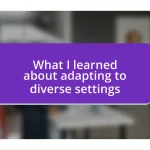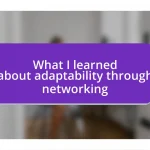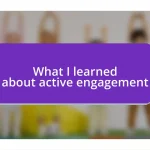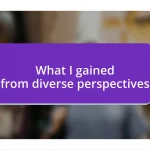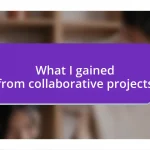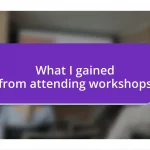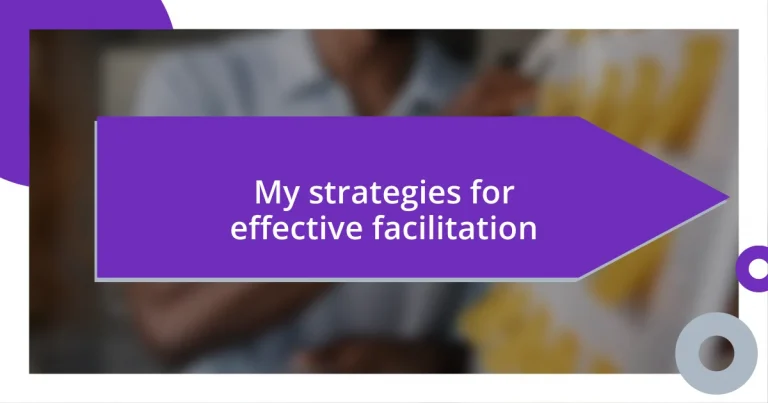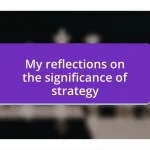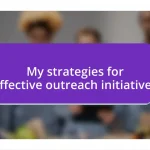Key takeaways:
- Facilitation is about creating a supportive environment where all participants feel valued and encouraged to share their ideas.
- Key skills for effective facilitators include active listening, neutrality, and time management to foster collaboration and deeper insights.
- Continuous improvement through feedback, ongoing education, and self-reflection is essential for facilitators to grow and enhance their impact.
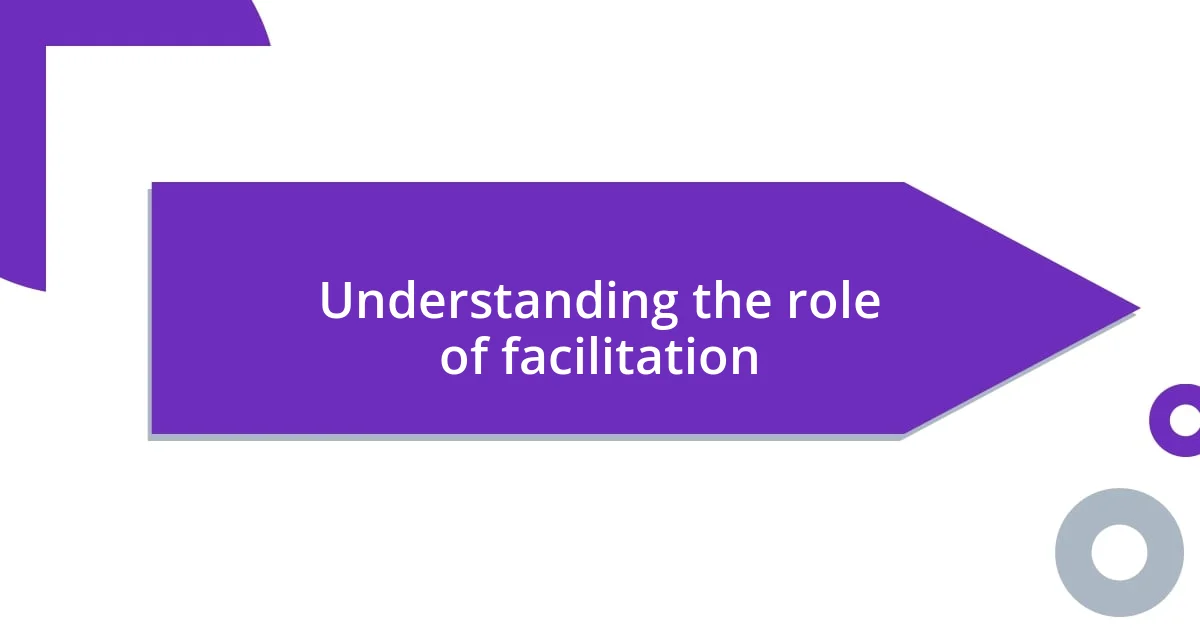
Understanding the role of facilitation
Facilitation is more than just guiding a discussion; it’s about creating an environment where everyone feels valued and empowered to contribute. I remember a workshop I facilitated where participants were hesitant to share their ideas, but by using open-ended questions, I slowly drew them out of their shells. Isn’t it fascinating how simply changing the dynamics of a conversation can unlock so much creativity?
The role of a facilitator is akin to being a conductor in an orchestra. Each participant is like an instrument, and my job is to harmonize their voices and ensure they are all heard. I’ve seen firsthand how a well-timed question can elevate the discussion and foster teamwork. Have you ever experienced a moment where a simple nudge led to a breakthrough in a group setting?
Effective facilitation requires active listening and adaptability. There have been times when I had to change my approach in the middle of a session because the group was going in an unexpected direction. It’s a reminder that flexibility is key; we must be willing to shift gears to meet the needs of the moment. How adaptable do you think you are in steering conversations?
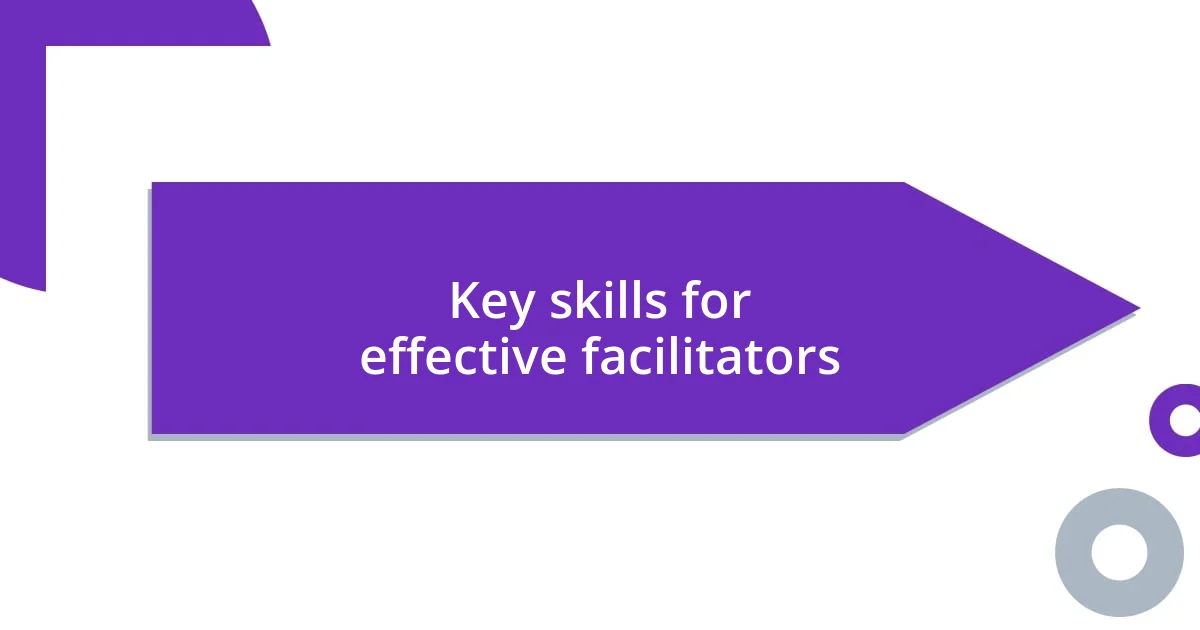
Key skills for effective facilitators
Successful facilitators wield a distinctive set of skills to guide discussions and foster collaboration. From my experience, one vital skill is the ability to engage participants with genuine enthusiasm. I recall a time when I entered a meeting that felt particularly stale. By injecting warmth and energy, the atmosphere shifted, and suddenly, participants were more willing to share their thoughts. The impact of positive energy in a room can be transformative.
Here’s a snapshot of key skills that are crucial for effective facilitators:
- Active Listening: Understanding not just the words, but the emotions behind them.
- Neutrality: Remaining impartial to encourage open dialogue without bias.
- Questioning Techniques: Crafting questions that stimulate thoughtful responses.
- Empathy: Connecting with participants’ feelings to create a supportive environment.
- Time Management: Balancing the discussion to ensure all voices are heard while staying on track.
Each of these skills contributes to creating a space where participants feel valued, leading to richer conversations and deeper insights.
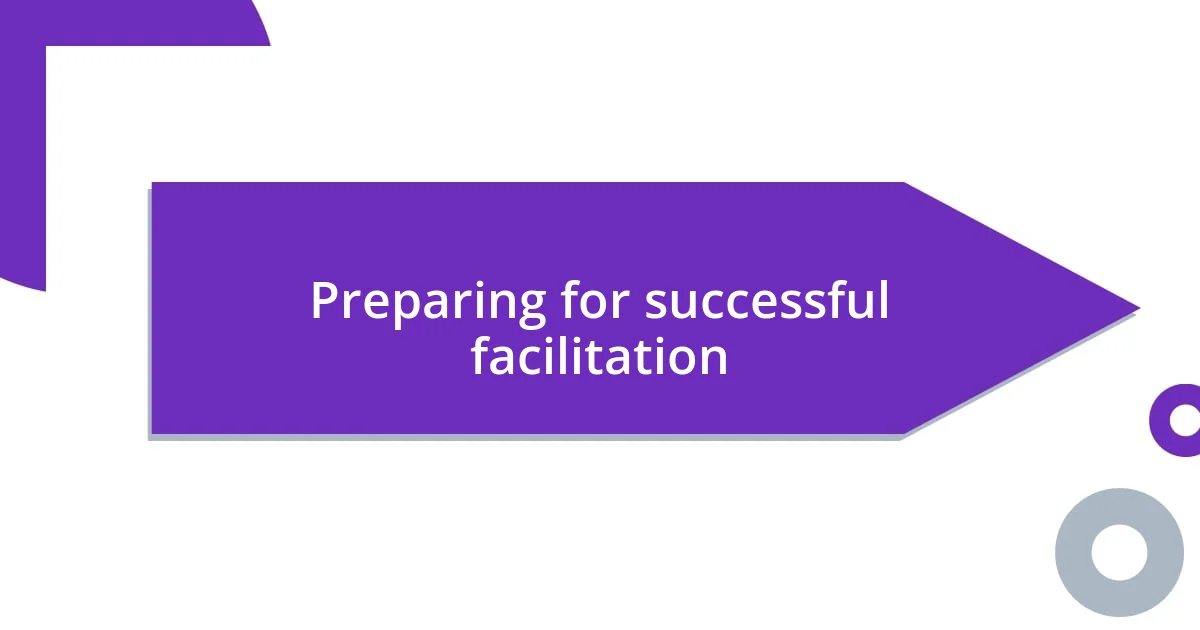
Preparing for successful facilitation
Preparing for successful facilitation involves thorough planning and a clear understanding of the group’s objectives. I always start with a solid agenda. Creating a structured outline helps keep the discussion focused and gives participants a clear picture of what to expect. During one session, I once neglected this step, and it led to an aimless discussion that frustrated everyone. Rushing into a meeting without an agenda can undermine trust and engagement.
Knowing the participants is equally important. When I take time to understand the diverse backgrounds and expectations of those involved, I can tailor my approach accordingly. I still recall a workshop where I discovered a mix of extroverts and introverts in the group. By adjusting my facilitation style to ensure quieter voices were encouraged to share, I fostered a more inclusive environment. Isn’t it remarkable how the right blend of personalities can shape a gathering?
Finally, setting up a welcoming physical and emotional space is crucial. I have learned that the arrangement of chairs and tables can influence interactions significantly. For instance, a circle often sparks more open communication than a traditional classroom setup. When participants feel comfortable, not just physically but also emotionally, they’re more likely to engage deeply in the conversation. Have you ever walked into a room where you felt instantly at ease? Those moments can make all the difference in fostering a successful facilitation.
| Preparation Step | Description |
|---|---|
| Agenda Creation | Establish a clear outline to structure the discussion and define objectives. |
| Understanding Participants | Learn about each participant’s background and expectations to tailor your approach. |
| Creating a Welcoming Space | Set up the physical environment to promote comfort and open communication. |
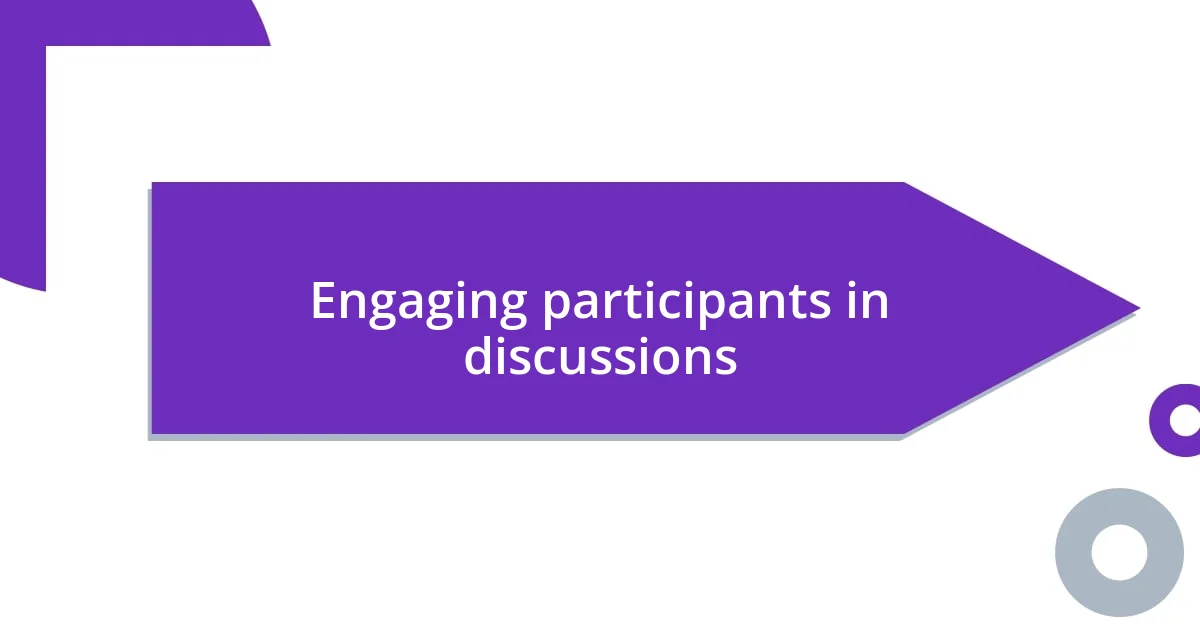
Engaging participants in discussions
Engaging participants in discussions requires more than just presenting a topic; it demands active involvement and personal connections. I remember a workshop where I decided to start with an icebreaker that asked participants to share their favorite project experience. The moment people began to share, I felt the room’s energy shift, sparking laughter and camaraderie. It was a vivid reminder of how opening up with a simple personal question can break down barriers and ignite participation.
Another effective method I’ve found is to invite different perspectives through open-ended questions. I once posed a question during a strategic planning meeting about a project’s biggest challenge. Instead of a single response, I was met with a chorus of ideas—each one uncovering a different facet of the issue. This variety not only enriched the discussion but also made everyone feel their opinion mattered, transforming the dialogue into a collaborative brainstorming session. Have you ever experienced that moment when a group collectively builds on an idea? It’s exhilarating!
Finally, embracing silence can be surprisingly powerful. In my experience, allowing a brief pause after posing a question gives participants time to reflect. I once instituted this practice during a team meeting, and initially, it felt uncomfortable. However, when participants started to share deeper insights, I realized it was a gift of space. Sometimes, giving people a moment to think leads to richer, more thoughtful contributions. Don’t you think that in our fast-paced world, we often overlook the value of a thoughtful silence?
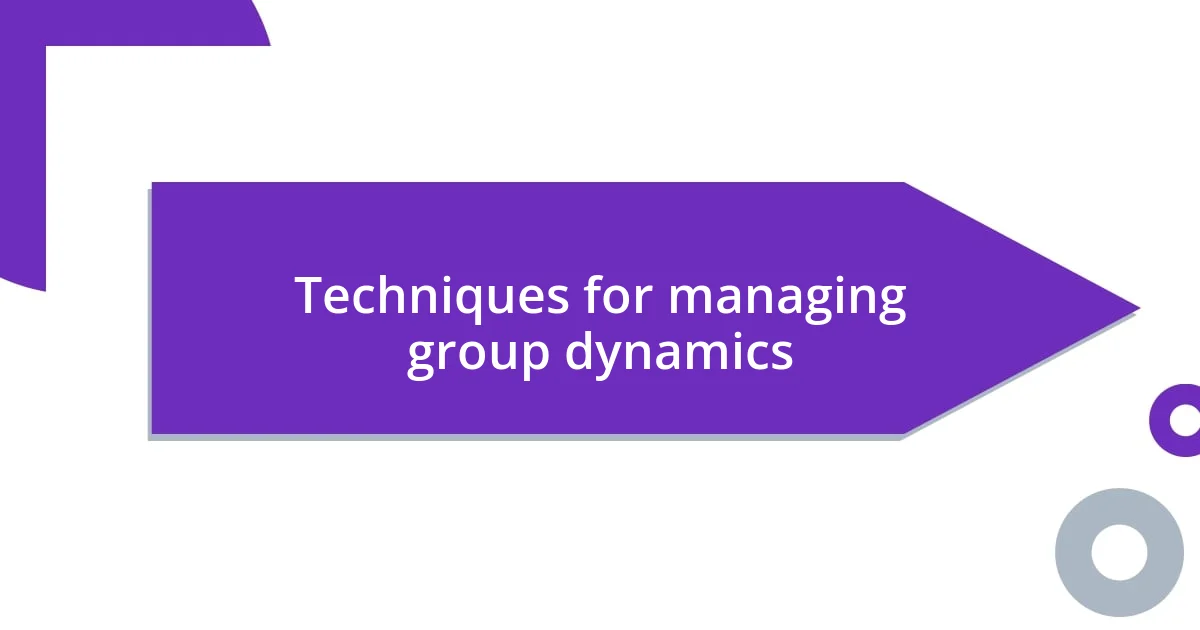
Techniques for managing group dynamics
Managing group dynamics effectively requires a keen sense of observation and adaptability. I once facilitated a meeting where I noticed a couple of participants dominating the conversation while others remained silent. To address this, I employed a technique I call “round-robin sharing,” where each person briefly voiced their thoughts in succession. This approach not only gave everyone a fair chance to contribute but also uncovered some hidden insights that enriched our discussion. Isn’t it fascinating how often we overlook quieter voices in a group setting?
Another strategy I find invaluable is the use of a “check-in” at the beginning of meetings. This practice invites individuals to share their current thoughts or feelings, establishing a shared emotional foundation. During one session, a participant expressed feeling overwhelmed by their workload. This openness prompted colleagues to offer support and insight, fostering a sense of camaraderie that transformed the group’s dynamic. Have you ever felt lighter just by sharing your concerns? It’s incredible how creating space for vulnerability can deepen connections.
Lastly, being attuned to nonverbal cues is a skill that can’t be ignored. I recall a workshop where I noticed several participants crossing their arms and leaning away, which signaled disengagement. Rather than ignoring these signals, I decided to directly address the energy in the room by inviting a brief movement break. It was amazing how a quick stretch and change of scenery reinvigorated everyone’s focus. How often do we forget that our bodies communicate just as loudly as our words? Paying attention to these subtle dynamics can be transformative in guiding the group toward collaboration and understanding.
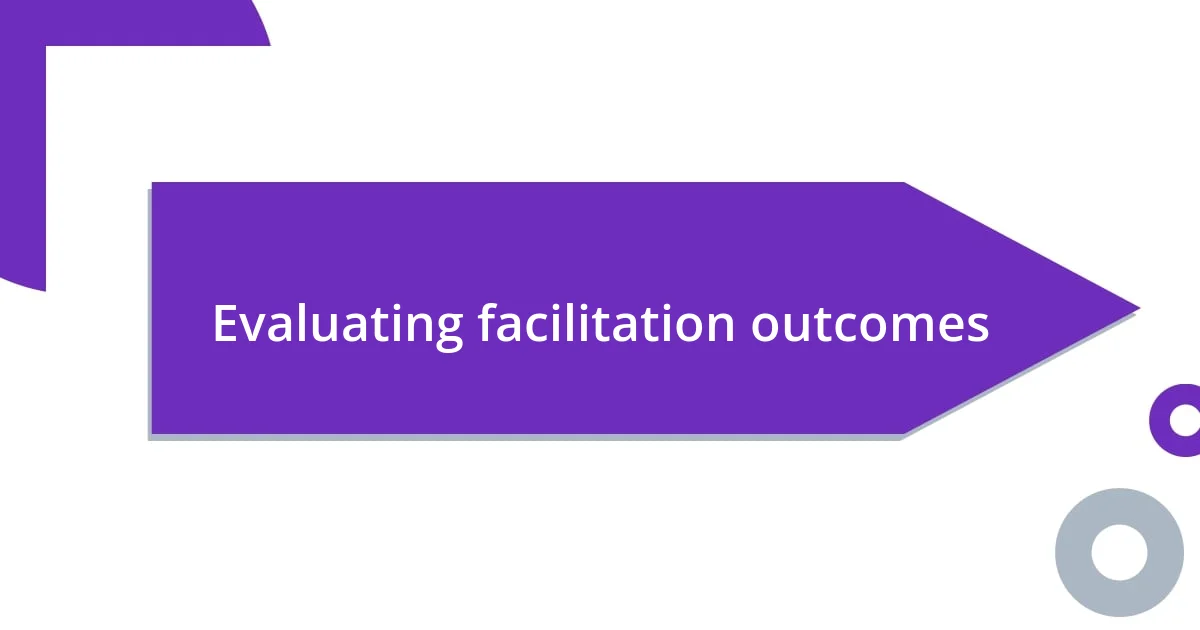
Evaluating facilitation outcomes
Evaluating facilitation outcomes is crucial for understanding the effectiveness of the strategies we implement. I recall a project debrief where we utilized surveys to gauge participant satisfaction. The feedback was eye-opening; while most felt engaged, some expressed a desire for more structured discussions. This revealed areas for improvement that I hadn’t initially considered, showcasing the importance of gathering diverse perspectives to measure impact.
One of the most revealing methods I’ve tried is post-session reflections, where participants share their key takeaways. During a recent workshop, one participant mentioned how a specific exercise helped clarify their project goals. Hearing moments like that not only validate my facilitation approach but also highlight individual impacts. Isn’t it fascinating how a single activity can resonate differently for each person?
Lastly, I’ve found it beneficial to track outcomes against predetermined objectives. At the end of a recent training program, I compared participant reflections to our initial goals and discovered we exceeded expectations in several areas. This data-driven approach reinforced my belief that effective facilitation isn’t just about the immediate experience; it’s about creating lasting change. What metrics do you use to evaluate success? It’s a question that can lead to deeper insights into our facilitation practices.
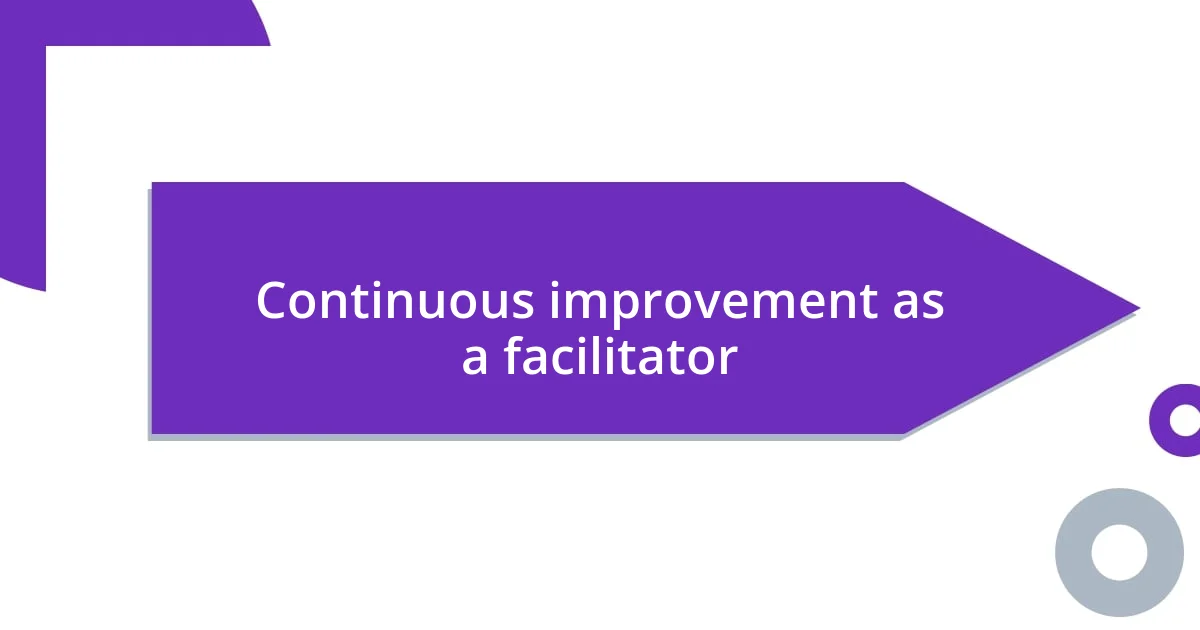
Continuous improvement as a facilitator
Continuous improvement as a facilitator is essential for growth. I remember the first workshop I facilitated where I felt completely out of my depth. I made mistakes, like overlooking the importance of pacing. Afterward, I sought feedback from participants, and their insights helped reshape my approach dramatically. Isn’t it interesting how mistakes can lead to major breakthroughs?
Another key aspect of continuous improvement lies in ongoing education. I regularly attend workshops myself, where I learn new techniques and explore fresh perspectives. One session introduced me to the concept of “active listening”—a practice I thought I was doing well until I realized I was often crafting my response instead of truly absorbing what was being said. How often do we default to our thoughts rather than focusing on the speaker? This awareness allowed me to enhance my interaction with participants significantly.
Additionally, I’ve started a personal journal to track my experiences and reflections as a facilitator. It’s a space where I jot down thoughts about what worked, what didn’t, and how I felt in the moment. Recently, looking back at my entries helped me recognize recurring challenges in group engagement. It was almost embarrassing at first, but this transparency paved the way for authenticity in my future sessions. Have you ever taken the time to reflect on your journey? Those insights can be the stepping stones to becoming a more effective facilitator.
